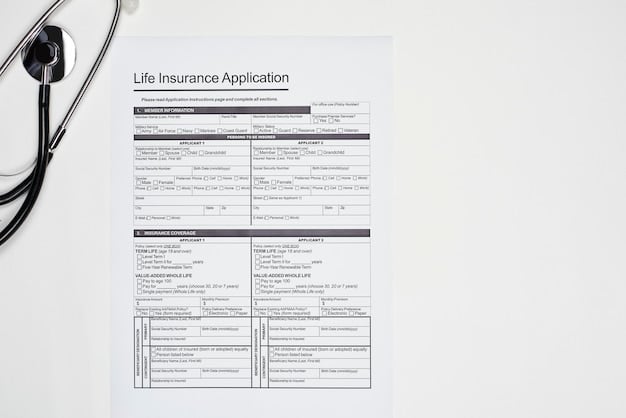Medicare Savings Programs 2025: Your Guide to Cost Assistance

Medicare Savings Programs (MSPs) can help eligible individuals with limited income and resources pay for their Medicare costs in 2025, including premiums, deductibles, and coinsurance, offering significant financial relief.
Navigating Medicare costs can be challenging, especially with fixed or limited income. Medicare Savings Programs: Get Help Paying Your Medicare Costs in 2025, are designed to assist individuals in managing these expenses. This guide provides essential information on these programs and how to access them.
Understanding Medicare Savings Programs (MSPs)
Medicare Savings Programs (MSPs) are initiatives by the federal government designed to help people with limited income and resources afford their Medicare coverage. These programs can assist with paying Medicare premiums, deductibles, and coinsurance, making healthcare more accessible and affordable.
These programs are vital for individuals who might otherwise struggle to afford essential healthcare services. By understanding the different types of MSPs and their eligibility requirements, beneficiaries can access the financial support they need to manage their healthcare costs effectively.
Who is Eligible for MSPs?
Eligibility for MSPs is primarily based on income and resource limits, which are set by each state but must adhere to federal guidelines. Generally, these programs target individuals and couples with low incomes and limited assets.
- Income Limits: These vary by state and are often based on a percentage of the federal poverty level (FPL).
- Resource Limits: These include savings accounts, stocks, and bonds. Primary residence and certain other assets are usually excluded.
- Medicare Enrollment: Applicants must be enrolled in Medicare Part A and, in some cases, Part B.
It’s important to note that eligibility criteria can change annually, so staying informed and checking the latest guidelines is crucial for those interested in applying.
In conclusion, Medicare Savings Programs aim to reduce the financial burden of healthcare for low-income individuals by providing assistance with Medicare costs. Understanding the basics of MSPs and their eligibility requirements is the first step toward accessing this valuable support.

Types of Medicare Savings Programs Available in 2025
Several types of Medicare Savings Programs are available, each offering different levels of assistance. Understanding these distinctions is essential for identifying the program that best suits your financial needs and healthcare requirements.
Each program has specific eligibility criteria and benefits, so it’s important to review each option carefully. The right MSP can significantly reduce your out-of-pocket healthcare expenses and improve your access to necessary medical care.
Qualified Medicare Beneficiary (QMB) Program
The QMB program helps pay for Medicare Part A and Part B premiums, deductibles, and coinsurance. To qualify, individuals must meet specific income and resource limits, which are typically the most stringent among the MSPs.
Specified Low-Income Medicare Beneficiary (SLMB) Program
The SLMB program assists with paying Medicare Part B premiums. To be eligible, individuals must have income and resources that exceed the QMB limits but are still below a specified threshold set by their state.
Qualifying Individual (QI) Program
The QI program also helps pay for Medicare Part B premiums. Unlike QMB and SLMB, the QI program operates on a first-come, first-served basis and requires annual reapplication. Income and resource limits are slightly higher than those for SLMB.
Qualified Disabled and Working Individuals (QDWI) Program
The QDWI program helps pay the Medicare Part A premium for certain disabled individuals who return to work. To qualify, individuals must have lost their eligibility for premium-free Part A due to their work income and must meet specific income and resource limits.
In summary, there are several Medicare Savings Programs available to assist with different aspects of Medicare costs, including premiums, deductibles, and coinsurance. Understanding the eligibility criteria and benefits of each program is crucial for choosing the one that best fits your needs.
Eligibility Requirements for Medicare Savings Programs
Meeting the eligibility requirements is a crucial step in accessing Medicare Savings Programs. These requirements typically involve income and resource limits, Medicare enrollment, and residency.
Understanding these criteria can help you determine whether you qualify for an MSP and which program is the most suitable for your circumstances. It’s important to gather the necessary documentation and information to support your application.
- Income Limits: States set income limits based on a percentage of the federal poverty level (FPL). These limits vary by program and are updated annually.
- Resource Limits: These include assets such as savings accounts, stocks, and bonds. Certain assets, like your primary residence and one car, are often excluded.
- Medicare Enrollment: Generally, you must be enrolled in Medicare Part A and, in some cases, Part B to be eligible for an MSP.
Additionally, some states may have specific residency requirements. Applicants must reside in the state where they are applying for the MSP.
In conclusion, understanding and meeting the eligibility requirements for Medicare Savings Programs is essential for accessing these benefits. Reviewing the specific income, resource, and Medicare enrollment criteria can help you determine your eligibility and choose the right program.

How to Apply for a Medicare Savings Program
Applying for a Medicare Savings Program involves a few key steps, including gathering necessary documentation, completing the application form, and submitting it to the appropriate state agency.
The application process can seem daunting initially, but with the right preparation and understanding of the steps involved, you can navigate it successfully. Ensuring you have all the required information and documentation will help streamline the process and increase your chances of approval.
Gather Necessary Documentation
Before starting your application, gather all the necessary documents to support your eligibility. This typically includes:
- Proof of Income: Pay stubs, Social Security statements, pension statements, and other documentation to verify your income.
- Proof of Resources: Bank statements, brokerage account statements, and other documents to verify your assets.
- Medicare Card: A copy of your Medicare card to confirm your enrollment in Medicare Part A and Part B.
Complete the Application Form
Application forms can usually be obtained from your local Social Security office or state Medicaid agency. Be sure to fill out the form completely and accurately. Provide all requested information and double-check for any errors or omissions.
Submit Your Application
Once you have completed the application form and gathered all the necessary documentation, submit it to the appropriate state agency. This may be your state Medicaid agency or a related state department. Follow the instructions provided on the application form for submission.
In conclusion, applying for a Medicare Savings Program involves gathering documentation, completing the application, and submitting it to the appropriate agency. Careful preparation and attention to detail can help ensure a smooth and successful application process.
Maximizing Your Benefits from Medicare Savings Programs
Once you are enrolled in a Medicare Savings Program, it’s important to understand how to maximize the benefits you receive. This includes staying informed about changes to the program, coordinating benefits with other forms of assistance, and managing your healthcare costs effectively.
Maximize your benefits by staying engaged with your coverage and understanding how it interacts with other resources available to you. This approach ensures you receive the full support you are entitled to.
Stay Informed
Medicare Savings Programs can change over time, so it’s important to stay informed about any updates or modifications to the program rules, income and resource limits, or coverage policies. Regularly check for updates from your state Medicaid agency or the Social Security Administration.
Coordinate Benefits
If you are eligible for other forms of assistance, such as Medicaid or Supplemental Security Income (SSI), coordinate your benefits to avoid duplication and maximize your coverage. Each program may cover different aspects of your healthcare costs, so understanding how they work together is crucial.
Manage Healthcare Costs
Work with your healthcare providers to manage your medical expenses effectively. Discuss treatment options, explore generic alternatives to prescription drugs, and take advantage of preventive services to stay healthy and avoid costly medical emergencies.
In summary, maximizing your benefits from a Medicare Savings Program requires staying informed, coordinating with other assistance programs, and managing your healthcare costs effectively. By taking a proactive approach, you can ensure you receive the full support you are entitled to and maintain access to affordable healthcare.
Common Mistakes to Avoid When Applying for MSPs
Applying for Medicare Savings Programs can be complex, and it’s easy to make mistakes that could delay or even disqualify your application. Being aware of these common pitfalls can help you avoid them and increase your chances of a successful outcome.
Avoidable mistakes can sometimes be the difference between receiving the financial help you need and facing unnecessary delays or denials. Preparing your application carefully and paying attention to detail can greatly improve your chances.
- Incomplete or Inaccurate Information: Ensure all information on your application is accurate and complete. Missing or incorrect details can lead to delays or denials.
- Failure to Provide Documentation: Include all required documentation, such as proof of income, resources, and Medicare enrollment.
- Exceeding Income or Resource Limits: Be aware of the income and resource limits for the MSP you are applying for. Exceeding these limits will make you ineligible.
Additionally, failing to reapply annually for programs like the QI program can result in loss of benefits. Many programs require annual renewal to confirm ongoing eligibility.
In conclusion, avoiding common mistakes when applying for Medicare Savings Programs, such as providing incomplete information or exceeding income limits, can significantly improve your chances of a successful application. Careful attention to detail and thorough preparation are key to accessing these valuable benefits.
| Key Aspect | Brief Description |
|---|---|
| 💰 MSP Overview | Helps with Medicare costs for those with limited income and resources. |
| ✅ Eligibility | Based on income and resource limits; varies by state and program. |
| 📝 Application | Requires documentation of income, resources, and Medicare enrollment. |
| 🤝 Maximizing Benefits | Stay informed, coordinate benefits, and manage healthcare costs. |
Frequently Asked Questions
▼
Medicare Savings Programs are government initiatives that help individuals with limited income and resources pay for their Medicare costs, like premiums and deductibles.
▼
Eligibility is based on income and resource limits, which vary by state and by the specific Medicare Savings Program. You must also be enrolled in Medicare.
▼
You can apply through your local Social Security office or the state Medicaid agency. You’ll need to provide documentation of your income and resources.
▼
MSPs can help cover Medicare Part A and Part B premiums, deductibles, and coinsurance, depending on the specific program and your eligibility.
▼
Stay informed about program updates, coordinate with other assistance, and manage healthcare costs effectively to ensure you receive all available support.
Conclusion
Understanding and utilizing Medicare Savings Programs: Get Help Paying Your Medicare Costs in 2025 can significantly ease the financial strain of healthcare for eligible individuals. By knowing the various programs, eligibility criteria, and application processes, you can take proactive steps to secure the assistance you need and maintain access to essential medical services.





